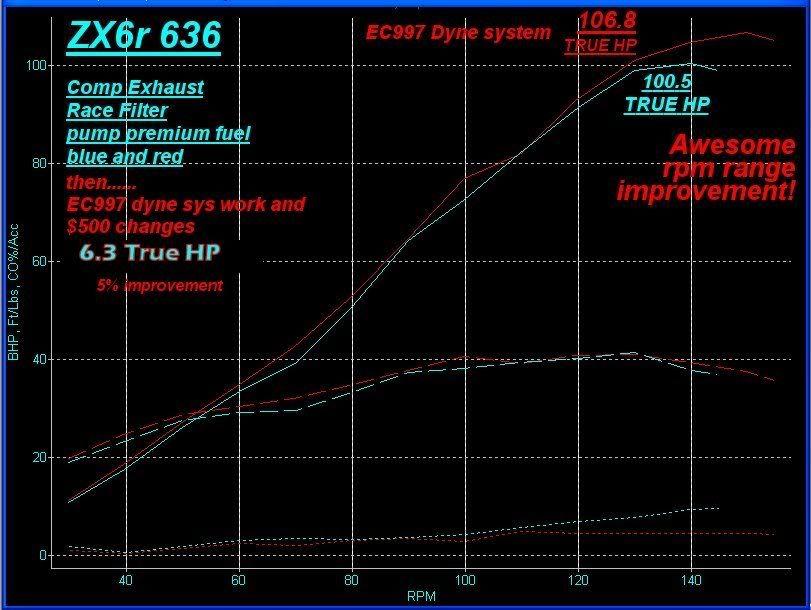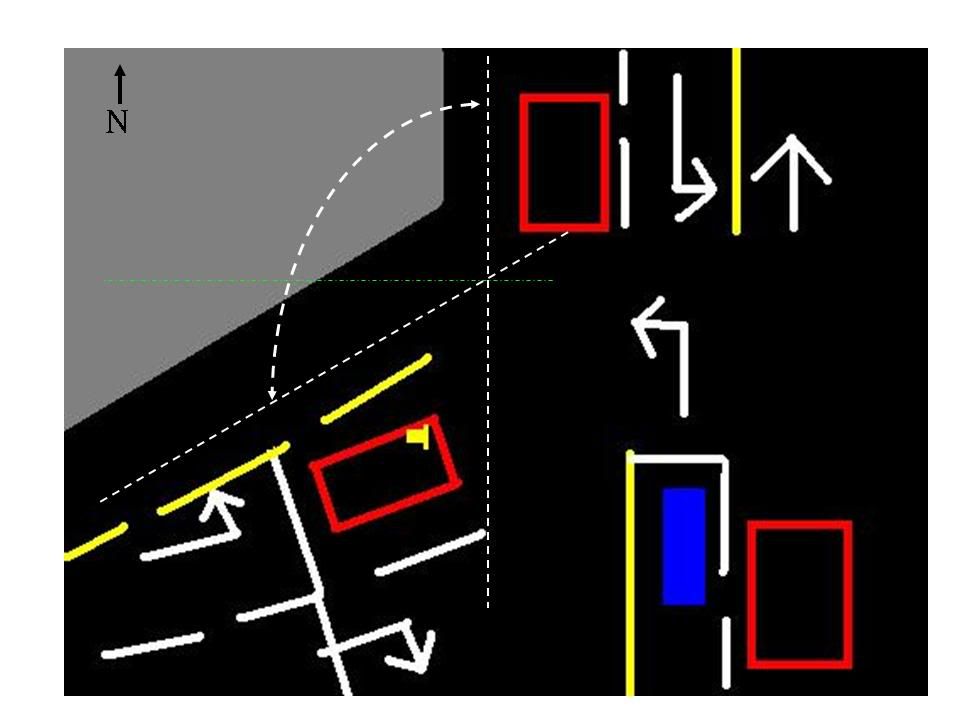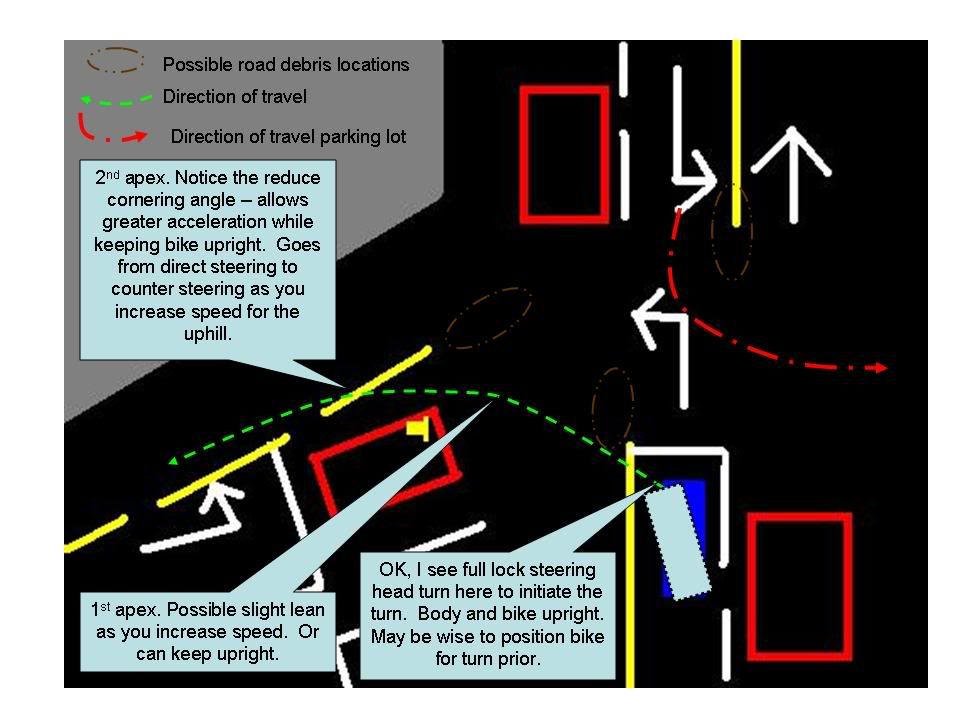|
|
Post by FightingFalcon on Jun 5, 2006 12:59:17 GMT -8
To my fellow bikers....what RPM do you try to keep your bike at? I was talking to some guys on a Kawasaki forum and the majority of them try to keep it at 6K so that they could rapidly accelerate should the need arise.
Since I'm in the break-in period (almost done thank God) I can't really go above 4K but that doesn't stop me....you just can't accelerate fast enough without breaking 4K.
Where do ya'll try to keep your bike? The suggested shifting speeds in the manual are ridiculous (9mph for 1st, 14mph for 2nd, and so forth....6th is only 30mph...that's just retarded) so generally I shift according to RPM and not MPH.
What about ya'll? What do you do for shift speeds and where do you try to keep your RPM at?
|
|
|
|
Post by 101ABN on Jun 5, 2006 19:39:54 GMT -8
"Where do ya'll try to keep your bike? The suggested shifting speeds in the manual are ridiculous (9mph for 1st, 14mph for 2nd, and so forth....6th is only 30mph...that's just retarded) so generally I shift according to RPM and not MPH. "
These sound like break-in speeds to me.
I don't have a tach but typically shift up or down by feeling the power curve (or just knowing where it is. A few thousand miles and you'll be able to feel it too.
|
|
|
|
Post by Husky23 on Jun 5, 2006 20:21:42 GMT -8
Shift by RPM....also feel - as 101 discribed, as you get more comfortable with the machine...you'll learn, feel, hear, sense it. But, to assist with that learning (especially for high performance machines), bearing in mind Harley V-twins operate at fairly low RPM's but display massive amounts of torque for this RPM -so hence many of thier bikes have no gauge. Shit, took me a moment to re-learn on my friends Fat Boy I rode, I was RPM limiting it at 5500 and thinking I should shift - Duh. While he on the other hand was shifting my Z1000 at like 2500-3000 RPM...and talk about an anemic pig - hell the bike don't even start making respectible torque or HP until 6 grand. Anyway....take at the Kawai 636 dyno below:  Notice where the Torque and HP curves meet....right arount 5500 RPM. That's your best pull range...below your bike will drag...sometimes blubbering so. At or slightly above....HP and torque pulling your bike. Now the best place to shift is at the maximum increasing of both HP and Torque...and in this dyno looks around a range between 7500-8000 grand - applying Max HP and Max grunt to the pavement. Word of caution: Even after break-in period, and especially cornering...winding a bike up to that range with that amount of potential torque and HP to slap to the pavement in a lean...is something to be learned...practiced, practiced, practiced....throttle and clutch control. I'd start at the 5500 RPM range...or lower and work your way. Remember Torque gets you moving quickest. HP moves you the fastest. The key is blending... |
|
|
|
Post by Husky23 on Jun 7, 2006 19:06:56 GMT -8
Haven't dumped it have you FF?
|
|
|
|
Post by FightingFalcon on Jun 7, 2006 22:32:47 GMT -8
Haha not yet Husky. I read your post and I'm still confused as to what I should do for shifting.
Obviously the break-in period is different from any other period of riding. But still...I can't be shifting to 2nd while going 9mph. That's dangerous and stupid. I'm not gonna do 30mph while in 6th cause that's dangerous - if I need to accelerate quickly, I'll be shit outta luck.
So the other night I rode my bike like a normal person would ride, e.g. shifting by RPM and not by speed. I tried keeping the bike at 6K RPM and downshifted if I came close to idling. I stayed in 3rd for the most part (went 40mph for most of the trip....I hit 80 in one back road though cause I couldn't help it and no cars were around) and just tried to ride it like a normal rider would.
But I felt like my engine was trying too hard. I'm not sure what an engine is supposed to sound like but this didn't sound right. Then again, I'm not used to an engine operating at 6K+ so maybe it sounded just fine. But when I was done with my ride my engine temp was 235 F. Anything above 240 is dangerous so I thought that that was kinda high. Maybe I'm overstressing my engine? I can't see how though...other than the occasional twisting of the right wrist, I can't accelerate that quickly cause of the traffic and speed limits.
My initial check is next week so I'll ask the dealer. I am just really looking forward to being done with the break-in period. I hate this shit.
EDIT: One more thing - I'm having trouble with less than 90 degree turns. I have two on my way to work that give me a little trouble. I'll try to draw a diagram tomorrow and ask you what to do.
|
|
|
|
Post by Husky23 on Jun 8, 2006 6:27:47 GMT -8
Didn’t mean to confuse FF… …actually I think you should just relax abit…don’t make it so much analytical work…it’ll come, you’ll learn, feel, hear what speed & RPM match for the proper acceleration/pull based on the road, weather, traffic conditions. Hell, sometimes I bee-bob around town in my near anemic power RPM range…because I don’t want that kind of tweakiness of the throttle that higher RPM/power causes, but my rig still makes fair torque at low RPM/gear ratio (too a point). Then other times (depending upon conditions and/or how the hell I feel) I’ll keep the motor humming at 5 - 6 grand or so (my bikes RPM range of real torque to the pavement). OK, bear in mind you have a sport bike. I mean a cutting edge crotch rocket that 10 years ago would be putting to shame factory racing machines on the world circuit. It is designed to operate at high to very high RPM’s (what’s your red line? Like 12 to 13 grand RPM or so?). Shit dude that’s where your machine develops max HP and Torque – and that’s some very fast spinning engine components. So yes, your bike will sound like it’s about to rip itself apart – like screaming. That’s normal actually…you just got to get used to it. Same with the temp (but I’m glad you watch it)…all modern bikes, and especially sport oriented machines run hot (and are designed as such), with a very small margin to over temp. My ole Suzuki TL1000 (bless her awesome V-twin) would near peg out, and sometimes I’d get the overtemp light in hot summer city traffic. My Triumph runs hot, especially in slow to stalled traffic on hot days (and it ain’t even summer yet). It is something to be mindful of…hence why sometimes I’ll lumber around at low RPM’s (to keep the temps low) or if the temps are nearing max and I’m stalled at a long light or traffic I turn my bike off, put the kick stand down and chill out for a few. These liquid cooled high performance rigs need air passing through the radiator. I’m near the end of my break-in. 150 miles to go…and alls well so I’ve blown the rest of my break-in RPM limits off. Red line is the limit now  Please…I’m curious as to what you mean specifically. When drawing indicate slope (up or down hill), camber (off camber or not), and accurate radius (constant, increasing or decreasing radius). Also, any road hazards (pot holes, cracks, debris?) and visibility issues?
|
|
|
|
Post by FightingFalcon on Jun 8, 2006 11:08:58 GMT -8
Haha its OK. There just seems to be two schools of thought in every aspect of riding. For example: Using rear brake vs. not using rear brake Using brake in a turn vs. not using brake in a turn Respecting the break-in period vs. riding it like you stole it I just gotta make up my mind as to which one I want to follow. Haha my red line is more like 18 and 19 RPM dude  I wouldn't even THINK of taking it up that far until I got 1000 miles though. The highest I've taken it so far was like probably 9 or 10, which is halfway. OK I just wanted to make sure that nothing was wrong with it. I'll post the drawing later today. Basically its like a 60 degree turn to the left uphill...I'll show you what I mean later. Thanks for the advice dude. |
|
|
|
Post by FightingFalcon on Jun 8, 2006 14:47:31 GMT -8
 OK Husky, that was the best that I could do with my lack of artistic talent. Basically this is what's going on.... Red = Cars Blue = Me White lines = well, white lines... Yellow lines = same Gray = sidewalk/buildings White arrows = flow of traffic Red car with yellow dot = car turning left onto the main road Slope = the main road has 0 elevation. The other road is a crazy hill...like a 45 degree incline as soon as you turn left off of the main road and onto the secondary road. OK so.....on the right hand side is a lane of traffic next to me that's simply going forward. Next to that is me in my Ninja. To the left is one lane of traffic going in the opposite direction. Directly in front of me is a lane for turning left (turning right by my point of view) into a parking lot (not in the picture). The biggest problem comes from people on the other road who want to turn left onto the main road. See how the white line is so far back and the red car is in front of the line? Whoever designed the intersection is retarded and put the stop sign WAY before the two roads meet. Because of this, cars pull way into the intersection. The red car is basically cutting off most of my entry space because he's trying to make a left. When there is no car there, the turn is pretty easy. But when there is a car there....it sucks. See what I mean by less than 90 degrees? I can't pull too far forward because there is a lane of traffic (the people turning left ACROSS the main road) but I can't cut corners either, because of the cars wanting to turn left ONTO the main road. Because leaning is impossible, I basically turn the handlebars all the way to the left as opposed to leaning. I also move my body all the way to the right of the bike, like I were doing a Figure 8. If I leaned tho, I would have to lean so far that my knee would probably hit the ground. There are a couple of intersections like that in my area, e.g. less than 90 degree turns that makes leaning impossible. How do you take them? Do you shift your body and turn the handlebars as well? |
|
|
|
Post by Husky23 on Jun 8, 2006 20:37:52 GMT -8
OK, you did confuse me abit with the “less than 90 degree turn”…cuase by this diagram I see greater than 90 degrees. It’s not about geometric measuring of the inside angle…it’s about direction change. So for instance let’s say this diagram is orientated North….and you are headed that way…to make this turn you must turn greater than 90 degrees – yes? So without my protractor, I’ma guessing this is about a 120 degree turn from your original direction of travel. Concur? Sorry, just wanted to get that outta the way for possible future clarification. So see this:  Now to the turn:  Low speed, like quite low, it's direct steering only...turn handle bars bike goes that way...plus body shifting. Higher speeds, or when gyroscopic precession of the wheels begin to take effect, then counter steering. Sometimes to slightly sway or change direction I shift on body wieght...again play with it. Did this help? |
|
|
|
Post by FightingFalcon on Jun 9, 2006 13:42:30 GMT -8
Yea, I see what you're saying here. I don't mean that the turn itself is less than 90 degrees but the roads are at a less than 90 degree angle when they meet. I would estimate that the roads are at like a 65/70 degree angle or so when they meet, as shown above.
Yea, that's basically what I was thinking as well. I always take the turn pretty slow (slower than normal turns), now I'm just gonna hafta practice shifting my body weight more to the right in order to keep the bike upright. I did the turn today coming home from work and it was fine, even though there was a car trying to turn left next to me.
I'll practice pre-positioning my bike as well and see how that works out.
Thanks for the help.
|
|